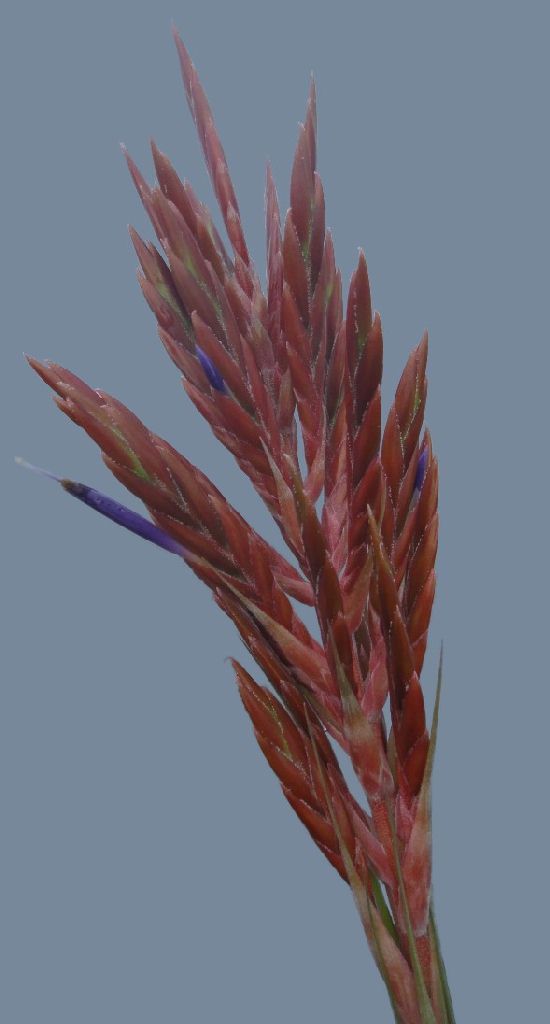
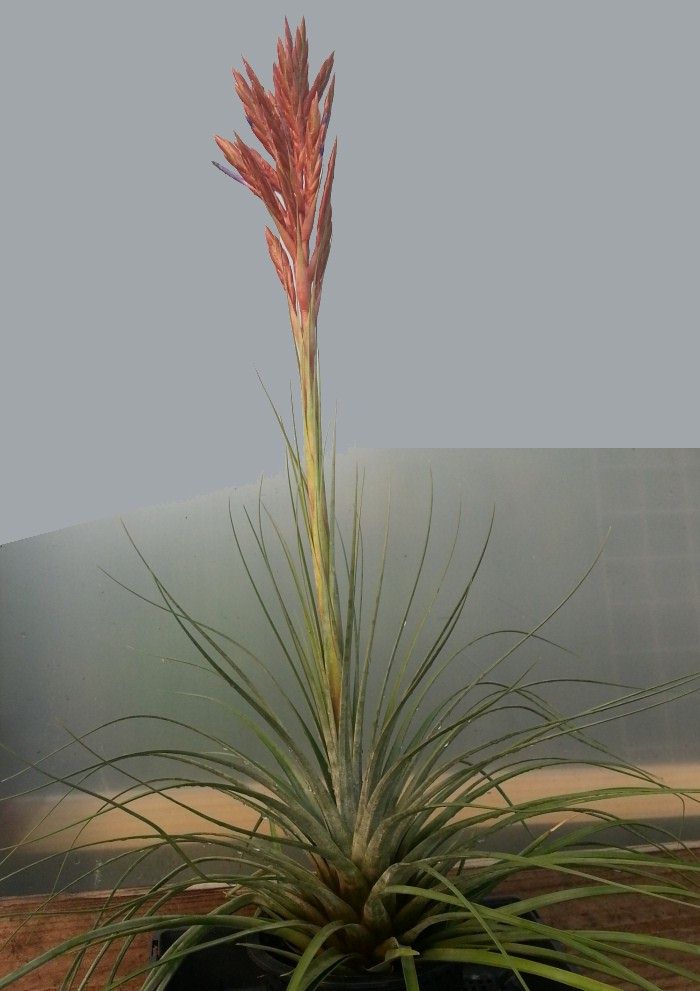
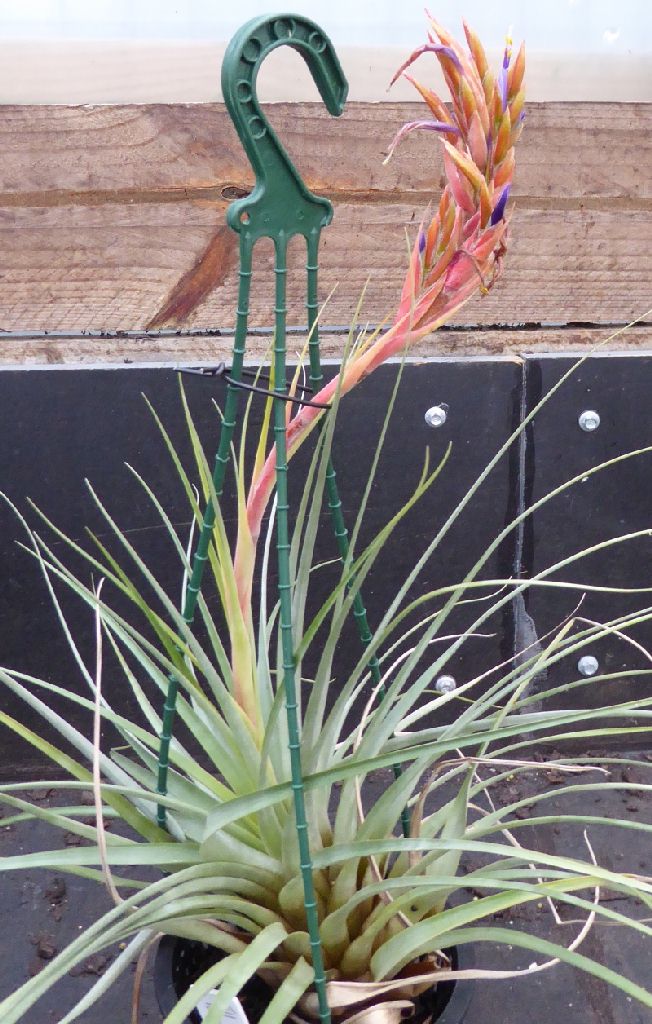
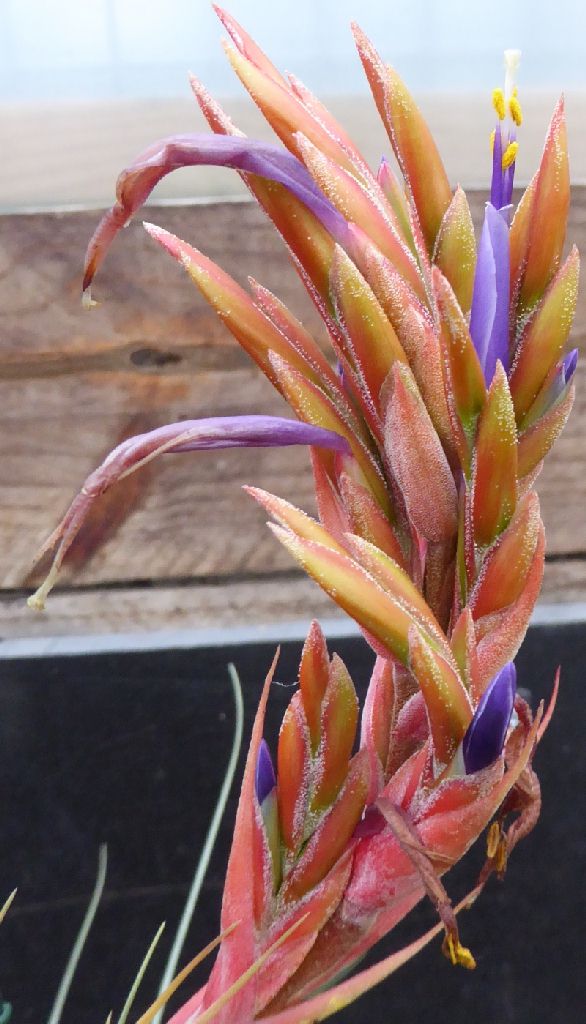
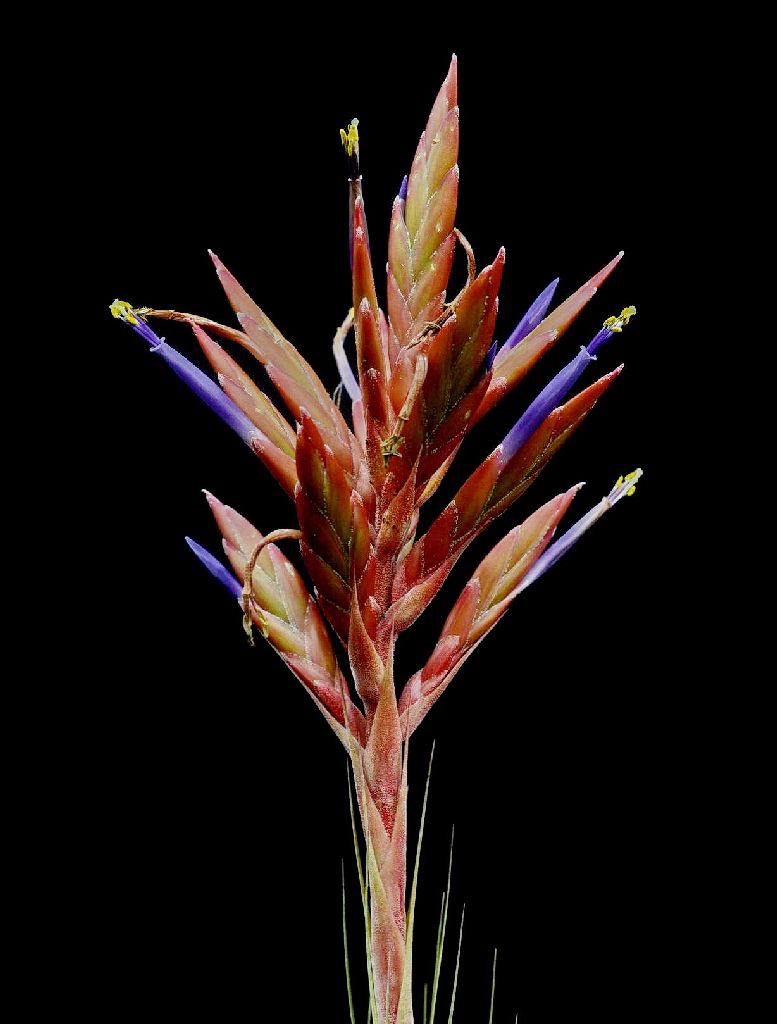
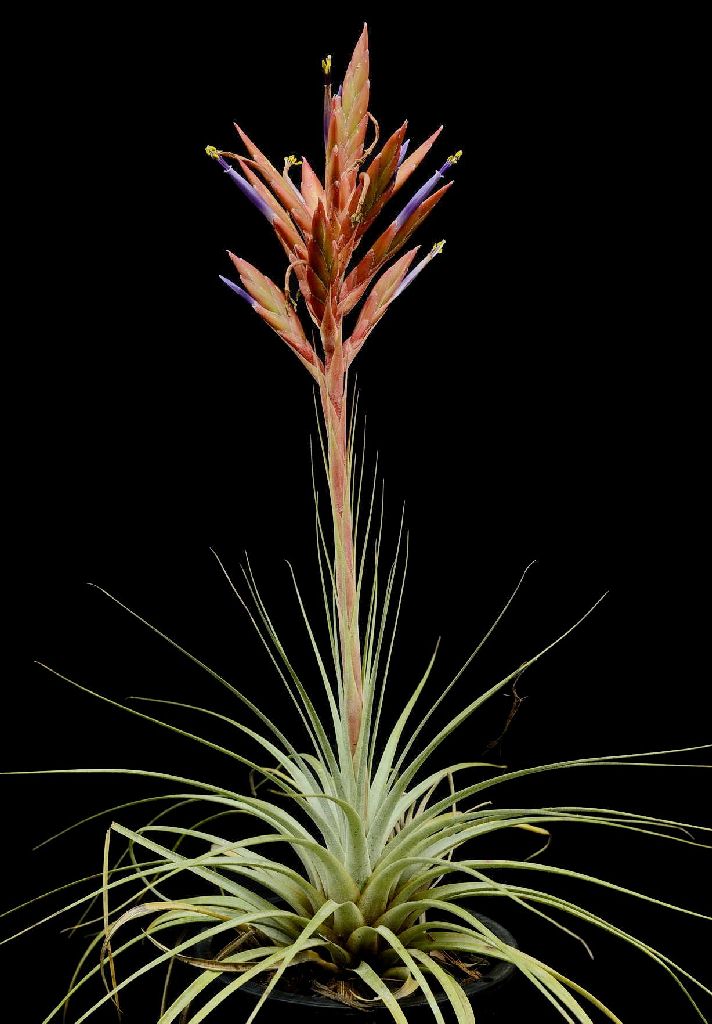
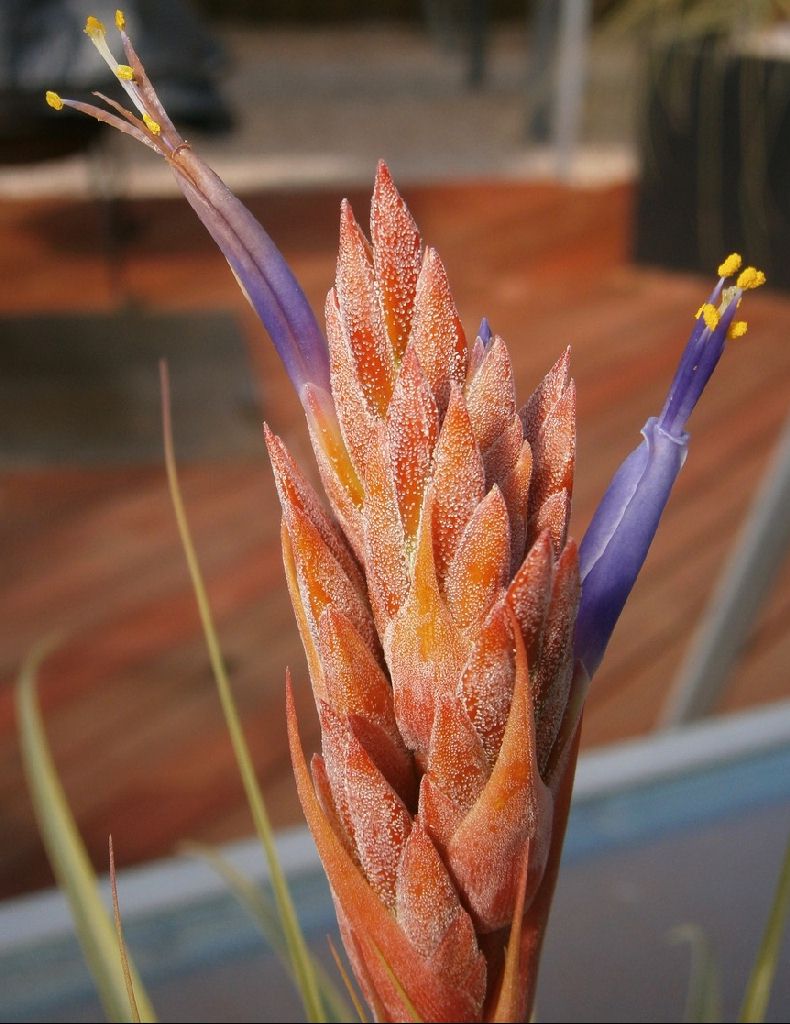
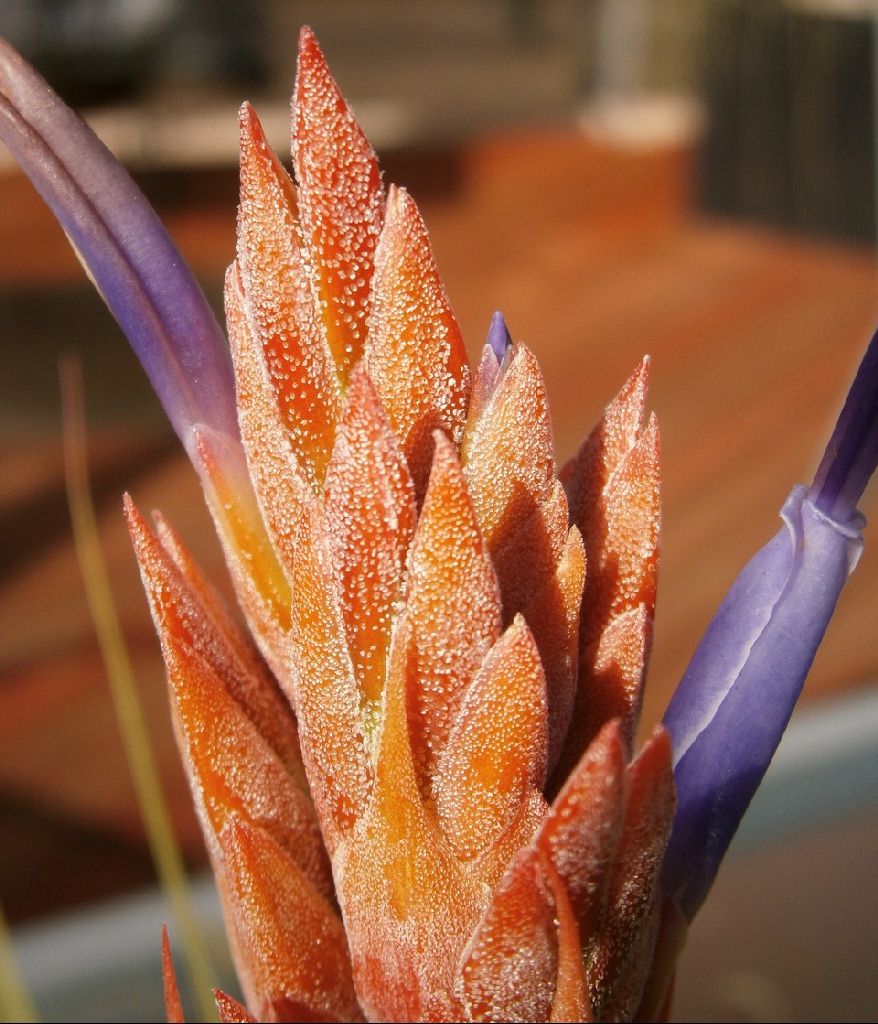
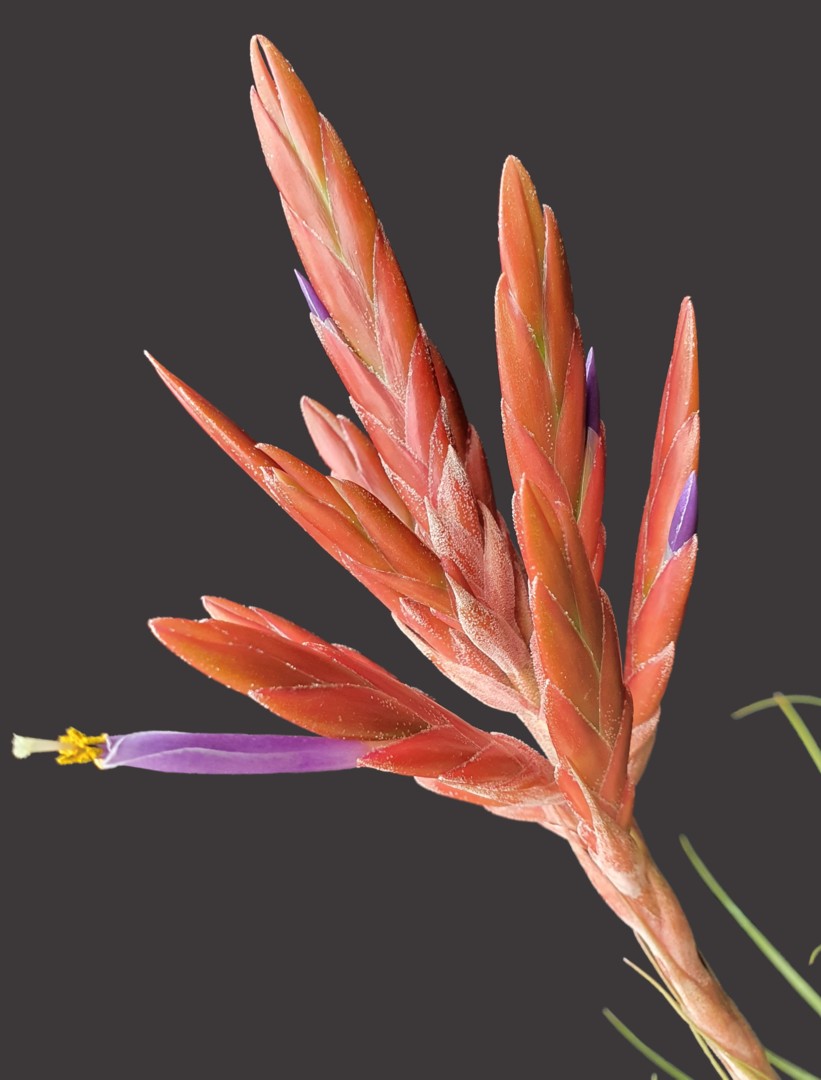
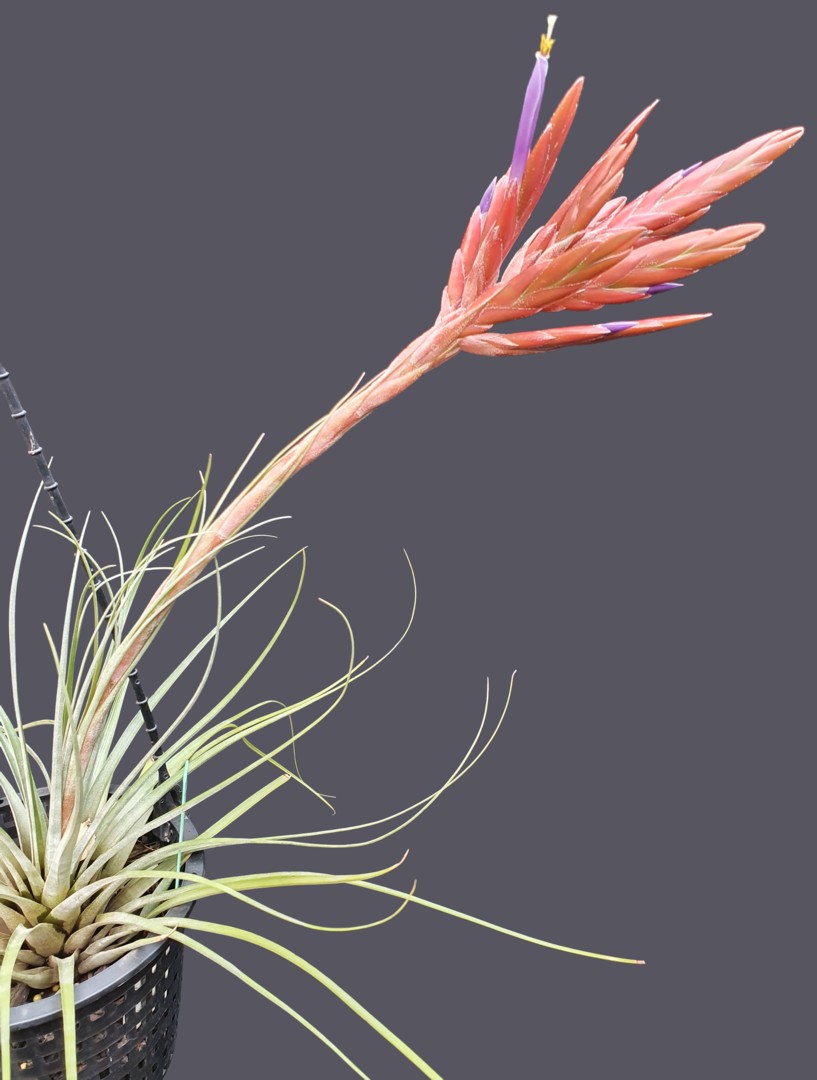
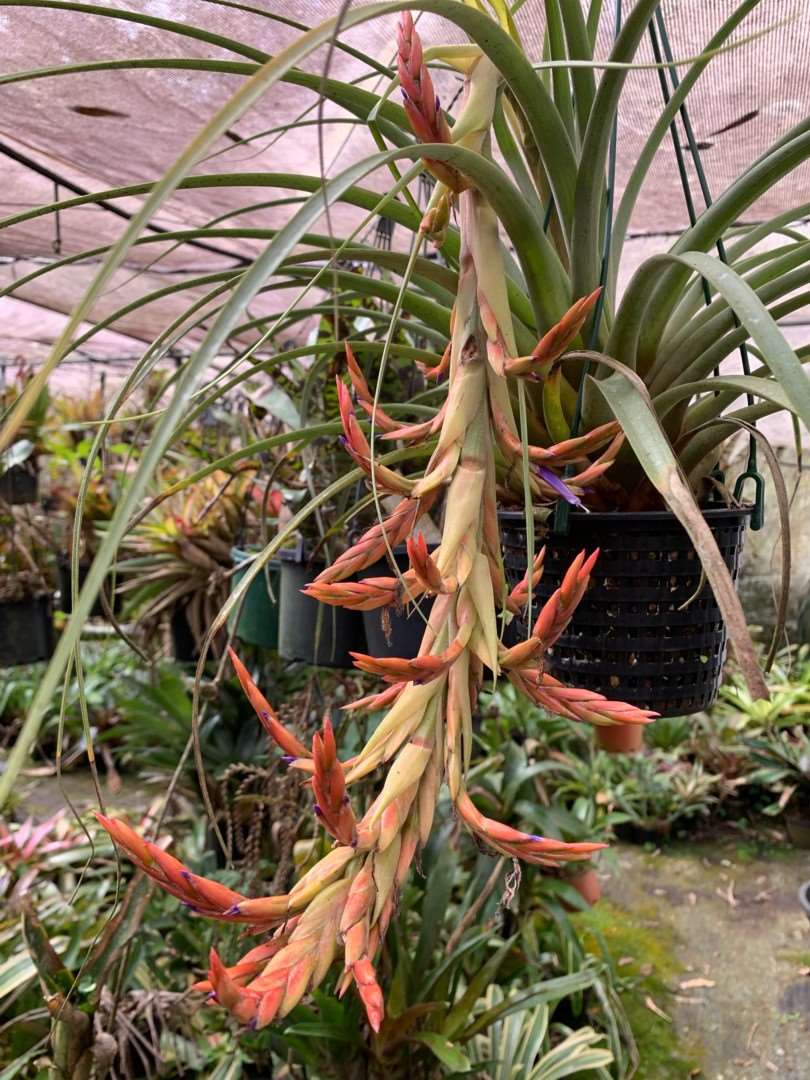
Plant stemless, growing epiphytically, individually or small groups, flowering up to 45 cm high, forming an erect extended, 25-35 cm high, 25-50 cm wide rosette, with numerous spirally arranged leaves.
Leaves leathery, dark-green, with brown sheath, both sides densely fine and appressed lepidote.
Sheaths somewhat erect and loosely over-lapping, distinct, 6-10 cm long, 2.5-5 cm wide, scaled with brownish appressed trichomes, abaxial side denser.
Blades 15-35 cm long, 2-3 cm wide next to sheath, narrowly triangular, long acuminate, with longer filiform tip, bent over, with weak asymmetric keel, the margins involute, densely grey appressed lepidote, abaxial side more dense.
Inflorescence partly erect, but often bent over horizontally.
Peduncle 7-20 cm long, mostly as long as the leaf rosette, round, ca. 7-8 mm in diameter, furrowed, red, almost glabrous, with a few large grey trichomes, enclosed imbricately by a few reddish peduncle bracts but not quite masked, the basal ones similar to the inner rosette leaves, up to 15 cm long and long acuminate, the upper ones only up to 4 cm and with a shorter tip, similar to the primary bracts.
Fertile part of the inflorescence 15-30 cm long, 2.5-3.6 cm wide, long-cylindrical, laxly branched, 10-15 side branches of 1st order, spirally and lax arranged, internodes of the basal spikes 2 cm long, the upper ones shorter.
Inflorescence axis partially visible, 4-6 mm wide, somewhat flattened, angular furrowed, red or reddish green, with scattered large grey scales.
Sheaths reddish or carmine red, primary bracts about a quarter as long as the spikes, joined to the broad side of the spike, the blade up to 4 cm wide, narrowly acuminate, the upper ones short tipped.
Spikes 4-6.5 cm long, 1.3-1.5 cm wide, narrowly elliptic, the apical spike wider than the others, pedicel up to 8 mm long, stout, flattened stem, occasionally one addorsed prophyll, ca. 2 cm long, opposite to the primary bract, the wide side towards the rachis, the basal half erect, appressed to the axis, the apical half spreading, with 5-7 sessile, scentless, distichously arranged flowers, densely imbricate, distance between the flowers ca. 5 mm, at the base 2-4 flowerless bracts, the flat and slightly wavy axis not visible at anthesis.
Floral bracts 2-2.6 cm long, 1-1.2 cm wide, slightly shorter than the sepals or of equal length, elliptic to triangular with a more or less fine tip, partly almost ecarinate, partly keeled towards the tip and base double-keeled, leathery with subhyaline margins, reddish or crimson, abaxial densely set with large, grey scales.
Flowers 5-7 per spike, sessile.
Sepals 2.1-2.3 cm long, 5-7 mm wide, lanceolate, acuminate, free, evenly connate ca. 2 mm with the ovary, thin membranous with a thicker middle, the posterior pair with strong red keel.
Petals forming an erect, narrow tube, apex slightly revolute, obtuse, 5-5.3 cm long, 7 mm wide, tapering up to 4 mm at the base, ligulate, violet, becoming white at the base.
Stamens distinctly exceeding the flower, in two circles of unequal length.
Filaments 5-5.6 cm long, elliptic in cross-section, 1 mm wide in the upper part, tapering to ribbon-like below, same colour as the petals.
Anthers 3 mm long, 1 mm wide, elliptic, yel1ow, joined versatile 1/4 from the base.
Style 5.6 cm long, upper third bright violet, becoming white below.
Stigma slightly wider than the style, lobes erect, not twisted, bright green, Type I Brown & Gilmartin (1984).
Ovary 7-8 mm high, 2.5 mm at the base, elliptic, bright green.
Habitat and distribution
Besides the type locality, this species was found at different other habitats in Guatemala: San Marcos, Huehuetenango, Quetzaltenango, Chimaltenango and Totonicapi (personal report by Uwe Feldhoff, Guatemala). Another habitat in Guatemala is located in the state of Quiche, between San Cristobal Verapaz and Uspantan at an altitude of 1250 m, where it grows on trees along with Tillandsia punctulata, T. welzii and T. multicaulis. At this locality, the plant was already collected in 1992 by me and my husband Klaus.
Similar species
The key of Smith & Downs (1977) leads to Tillandsia schultzei Harms, or, assumed that the peduncle is erect, to T. vicentina Standl. Tillandsia schultzei belongs to the Subgenus Allardtia and therefore, there is no relationship.
Because of the long cylindrical inflorescence, T. vicentina Standl. var. wuelfinghoffii E. Gross is probably the best choice for a differential diagnosis.
The plant differs from Tillandsia vicentina Standl. var. wuelfinghoffii E. Gross, in the following characters:
Leaves much longer, sheaths 10 cm long (instead of 5-7 cm), blades up to 35 cm long (instead of 20 cm), above the sheaths 2.5-3 cm wide (instead of 1.5 cm), peduncle bent over, not erect, inflorescence longer: long-cylindric, 15-30 cm long (instead of short-cylindric, 10-15 cm long), much laxer with spreading spikes, internodes between the spikes longer, sheaths of prirnary bract shorter, only about half as long as the spikes (instead of slightly shorter than the spikes), the spikes longer, up to 6.5 cm long (instead of 3-4 cm), floral bracts longer, up to 2.6 cm long (instead of 2 cm), slightly carinate (instead of sharply carinate), sepals longer, up to 2.6 cm (instead of 1.6 cm), petals longer, up to 5.3 cm (instead of 3 cm).
There is some similarity with Tillandsia bochilensis, too:
From Tillandsia bochilensis R. Ehlers (1990) the new species differs in the following characters:
In habit, the plant resembles Tillandsia bochilensis, the peduncle, however, is not erect but bent over, much shorter: the inflorescence not much exceeding the leaves (up to 20 cm), narrower: only up to 3 cm (instead of 5-6 cm) wide, spikes much more lax with much longer internodes, spikes half as narrow only up to 1.5 cm wide (instead of 3 cm), rhachis at the time of anthesis not visible, floral bracts narrow red (instead of green to pale orange), sepals much longer: up to 2.3 cm (instead of up to 1.7 cm) long, petals much longer: up to 5.3 cm (instead of up to 3.7 cm) long, filaments and style longer.
Prologue
From his Guatemala trip in 1999 with Manfred Kretz and Jurgen Brinkmann, Jurgen Lautner brought an interesting plant that he had collected on 17 February 1999, between Tecpan and Chimaltenango. While visiting Jurgen Lautner in 2000, several of these plants were flowering in his collection in the garden. They were marvelled at by all bromeliad fanciers present and were appraised.
Jurgen first assumed that it might be a hybrid, then he considered that there were many plants, all of the same habit, at the locality, so he consequently assumed that it probably was a new species.
We prepared a description of the plant and compared it with the species that were similar, and above all with Tillandsia vicentina Standl. var. wuelfinghoffii E. Gross (1987), that we had found on several trips in Mexico and Guatemala at many places. We agreed that the plant had sufficiently different characters for it to be a new species, but since we were not sure whether or not it was a hybrid, we did not publish the description.
In 2010, I visited Guatemala with Uli Lautner, Manfred Kretz and Jan Claus. Unfortunately, our friend Jurgen Lautner could no longer be with us and again and again we remembered how much we missed him. It was very important to me to visit the location myself, and on March 1st we were at the locality near Tecpan. There, we found only these plants but no possible parents for a hybrid. The only other Tillandsia that we found were T. ponderosa, T. guatemalensis and a single specimen of T. lautneri. We photographed and collected some plants. After returning to Guatemala City some of the plants were given to Uwe Feldhoff as a gift. The plant was new to him and so he asked for the exact locality.
Jan Claus reports in his diary about his visit to the locality of Tillandsia tecpanensis:
Monday, 1 March 2010 -
Tillandsia tecpanensis sp. nov.
Early in the morning we drove to the Department of Chimaltenango, before reaching Tecpan we stopped and searched the trees for Tillandsias. We saw many T. ponderosa, T. guatemalensis, and a Vriesea sp. Uli found a clump of T.lautneri, that grew here in isolation. Further down the road, we discovered T. tecpanensis sp. nov. in the treetops. Renate had completed the description of this but she did not publish it because she was not sure whether it might be a hybrid.
Since we have found this species frequently in this area, T. tecpanensis sp. nov. can be considered to be a true species.
Now that it is undoubtedly proven that it is not a hybrid, I have decided to publish name and description. It makes me feel very sad, that my friend Jurgen was not able to see that the plant he discovered now has been given a name, he would have been happy about it:
Tillandsia tecpanensis Ehlers & Lautner. While re-working the description, all the many beautiful trips with Jurgen, the good cooperation, our common studies, discussions and great conversations came flooding back.
And now, in the end, after the article had been finished by the editorial staff, whilst on a visit of Jan Zima in my collection, I realized that a plant that I collected in 1992 and that was flowering in my collection in July 1994 and May 2011, was identical to Tillandsia tecpanensis. This plant was collected in March 1992 while travelling with my husband Klaus in the Dept. Quiche near Uspantan. I had been uncertain if this plant perhaps could be a hybrid, too. But now after intensive comparison, I determined it to be identical to the type collection of T. tecpanensis.